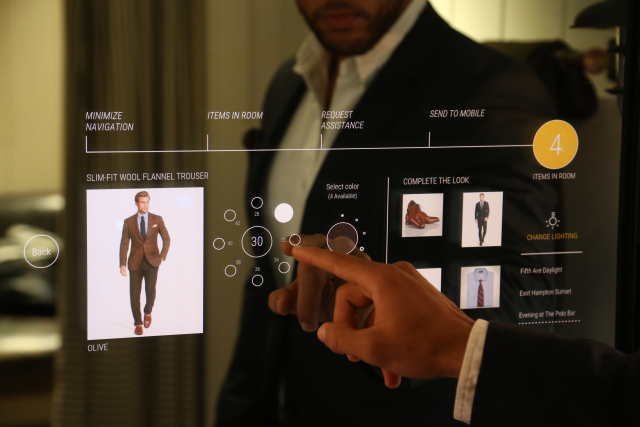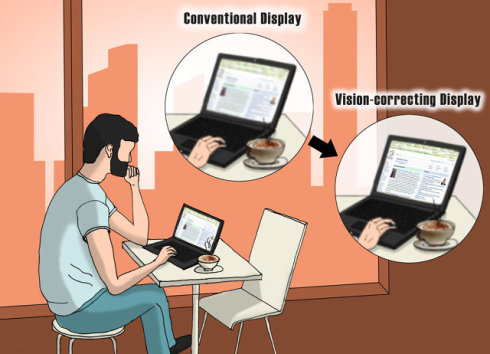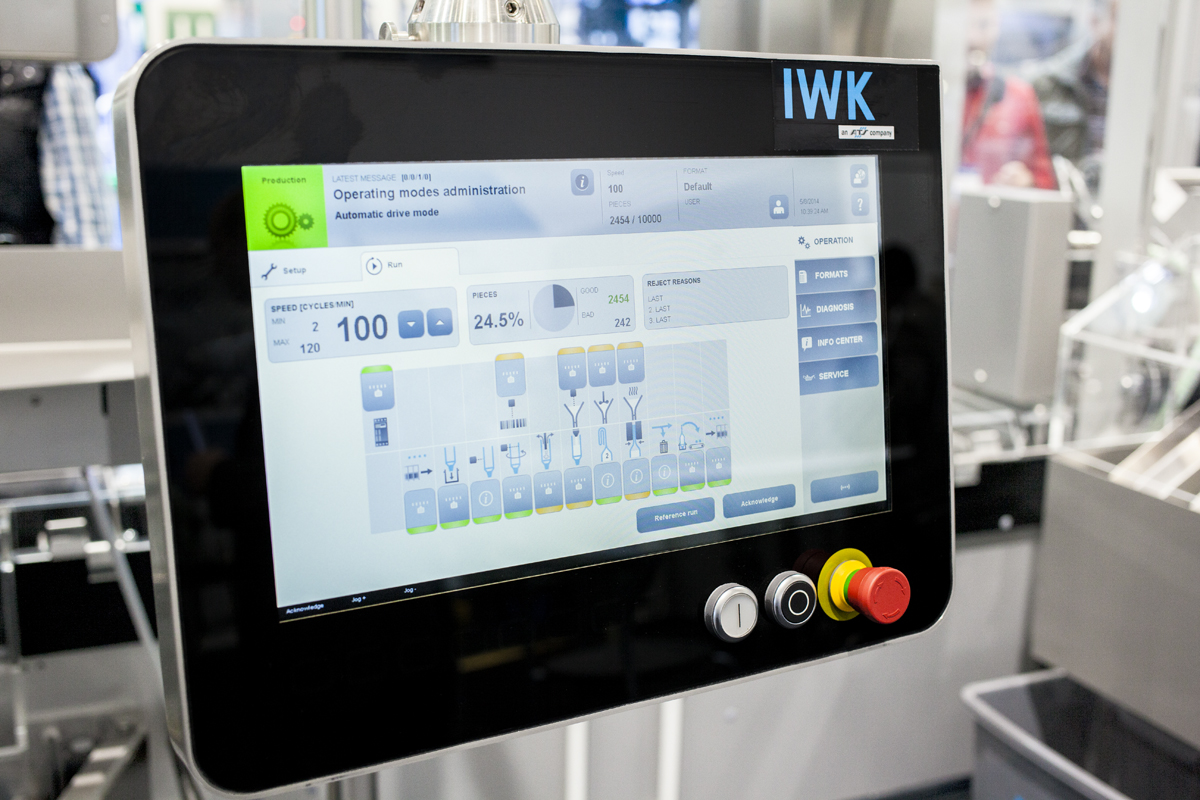Display Technology News Roundup 12.1.2015

Image via Oak Labs / Polo Ralph Lauren / Thomas Iannaccone
Display Alliance is sponsored by Smarter Glass (www.smarterglass.com), a leading distributor and solutions provider with nearly 15 years specializing in the global LCD display industry and PCAP touchscreens. This blog is an open resource for the display industry and welcomes content and sponsorship from readers. Contact us to discuss how we can work together on Display Alliance. For display panels, visit the Smarter Glass display database to search and compare thousands of panels side-by-side.
How are touchscreen mirrors and RFID detection updating Polo Ralph Lauren's fitting room? "Now, thanks to Oak Labs, fitting room mirrors are wising up enough to help you shop. You can find other sizes and colors of that suit that’s almost right, or by keeping the hovering salespeople at bay, summoning them, or sending them for items with a tap of its touchscreen. ...The room knows which items you brought with you to try on and the touchscreen mirror displays them. On the mirror you can run through item details, and if you try a piece on and see it’s not quite right, you can pick out a different size or color with a simple tap. When you’ve found what you want, you can check out with another tap. It’s like Oak Labs combined the privacy and ease of shopping online at home with the classic and classy retail experience, including the chance to try things on. (Video)" via Digital Trends
What Is Virtual Reality? Everything You Need to Know About VR "However, the definition of VR is a sticky one. While many digital products bill themselves as VR, technically, they aren’t. “VR is a totally occluded experience,” says Fouché. In other words, he says, it’s “completely closed off from your natural world.” So, it should be a different reality that you can see, hear, and interact with. But most VR experiences being shown through these smartphone setups aren’t at all interactive. Instead, they are actually just immersive video. For instance, the New York Times recently released an immersive documentary called The Displaced, which let viewers explore the environments of three children living in war-torn worlds. True VR would have let the user interact with the environment or the films’ subjects. Likewise, last month’s Democratic debate was broadcast in VR. The real world event took place in Las Vegas, but Samsung VR owners could watch the immersive feed — though not interact with the participants (thank goodness) — from their living rooms. “The graphics were so poor they looked more like faceless avatars than human beings,” wrote TIME’s Alex Fitzpatrick. In fairness to the programmers behind this effort, come election season, most politicians look like faceless avatars." via Time
Volvo and Microsoft demonstrate HoloLens tech for showrooms "According to Volvo, the HoloLens system may also free some dealership staff from the showroom floor, with the technology allowing them to setup pop-up stores and interactive displays in shopping centres or main streets. Volvo has also postulated that, one day, the augmented reality technology may also find its way onto the production line, providing workers there with always visible builds sheets. (Video)" via CarAdvice
New medical display technology uses Virtual Reality inside MRI "Toshiba Corporation and Toshiba Medical Systems Corporation have developed a technology for displaying expansive virtual reality images inside the bore of MRI systems. High reality images are projected onto a dome-shaped screen (dome screen) in the bore to take the patient's attention away from the actual examination space. ...A semi-transparent dome screen that is moved in synchronization with the patient table is installed inside the bore, and images are projected onto the dome screen and bore cover from a projector, which is installed behind the MRI system, and whose location is unaffected by the magnetic field. The images are reflected by a mirror installed on the patient table and can then be viewed by the patient, providing a visual space that helps take the patient's attention away from the actual examination space." via MedicalXpress
Display database for engineers Search thousands of display panels by multiple characteristics and compare results side-by-side using the display database multisearch.
What is PCOLED? Will It Replace OLED? "RGB OLED may form the basis of a number of high end TV and smartphone displays, including new flexible designs, but the technology could one day be replaced by an improved Plasmon-Coupled Organic Light Emitting Diode (PCOLED) architecture. Taiwan-based ITRI has announced development of its PCOLED design, which could boost the lifetime of displays by up to 27 times. PCOLED replaces the traditional red, green and blue phosphorescent color layers used to produce white light with a red, green and green plasmon-coupling phosphorescent design, complete with a double metal structure." via Android Authority
Chicago Projection Mapping Display at New UChicago Research Center "The display was positioned inside of a conference room, and featured objects that looked three-dimensional and showed off the event's theme and branding. An associate could approach the wall and press on an area that would start the next segment of the feature. ...Using 3D displays to impress guests, administrators, and donors is becoming more common along with the demand for displays that reflect a national emphasis on STEM: science, technology, engineering, and mathematics programs. (Video)" via AVNetwork
Head-Up Display Adopted by Jaguar Land Rover "The technology – which was conceptualised in the University's Department of Engineering more than a decade ago – is now available on all Jaguar Land Rover vehicles. According to the researchers behind the technology, it is another step towards cars which provide a fully immersive experience, or could even improve safety by monitoring driver behaviour. ...The HUD technology developed at Cambridge is the first to use laser holographic techniques, which provide better colour, brightness and contrast than other systems, but in a smaller, lighter package. It provides key information to the driver without them having to take their eyes away from the road. But according to Chu, the technology's potential has yet to be fully realised, and its real advantage is what it could be used for in future models. "What we really want to see is a fully 3D display which can provide much more information to the driver in a non-intrusive way – this is still a first generation piece of technology," he said." via Phys.org
Could new touchscreen material end daily smartphone charging? "Developed by Bodie Technologies, a University of Oxford spin-off company, the new display is reportedly made from a type of phase-change material called germanium-antimony-tellurium, or GST. The researchers are being understandably cagey about exactly how it’s made as they shop the technology around, but it’s based on a paper they published last year describing how a rigid or flexible display can be formed from microscopic 'stacks' of GST and electrode layers. ...They say their ultra-thin display material can produce vivid colour displays at very high resolution - even when hit with bright, direct sunlight - because of the way it manipulates incoming light. "This makes them potentially useful for 'smart' glasses, foldable screens, windshield displays, and even synthetic retinas that mimic the abilities of photoreceptor cells in the human eye," says the team. With very little electricity required to illuminate a display made from this special 'GST sandwich' configuration, the team says they could dramatically cut the overall amount of power consumed by a smartphone." via Science Alert
Do you have content to share with Display Alliance? Anyone can post press releases, white papers, commentary, videos, and more in the open section.
Do Your Diagnostic LCD Monitors Meet the Guidelines? "The guidelines that were originally introduced by the AAPM Task Group 18 (also known as TG-18) in 2005 were widely accepted and adopted at radiology departments across the country. The updated Technical Standard was produced in 2012. There are several changes in this update that apply to more than just displays, and every practice should thoroughly study all of the details in the document. As it applies to displays, though, some of the most notable changes include: 1. LCD panel technology: An LCD technology with wide viewing angles is recommended. TN (twisted nematic)-type LCD panels should not be used. 2. Connectivity: Digital connectivity, such as DisplayPort, HDMI, or DVI-D is recommended instead of VGA. 3. Brightness: In the new standard, monitors used for diagnosis must meet a minimum brightness of 350 cd/m2 (candelas per meter squared), while monitors used for interpreting mammograms must be at least 420 cd/m2. For other types of displays (typically referred to as clinical or review displays), the minimum calibrated brightness starts at 250 cd/m2. When the updated guidelines were introduced in 2012, there were no requirements for when they needed to be implemented. As a result, the new guidelines didn't have any teeth. Today, three years after they were introduced, only a few organizations have upgraded their procedures and equipment to meet the new standards." via DiagnosticImaging
Are you using Apple's 3D Touch at all? "When Apple unveiled 3D Touch, the company’s new input method for the iPhone 6s and 6s Plus (and, inevitably, other Apple-branded products), they made no effort to hide the fact they believe this is as important a feature as multitouch was all those years ago when it was first unveiled. They might be right, because obviously 3D Touch is only going to get better, more advanced as the years click forward. ...Right now I look at 3D Touch saving me a second, sometimes, and that’s not a second that needed saving. I’m not using 3D Touch right now because muscle memory is winning out over incorporating a new way to interact with my smartphone, but I don’t think that will always be the case. I think it would be pretty great if 3D Touch could give me interactive elements outside of the app." via PhoneDog
ShiftWear uses e-ink display to spruce up your sneakers "Once limited only to e-book readers, we've seen some rather innovative experiments that put e-paper displays or EPDs on more flexible material, like, say, a bracelet. Now David Coelho is presenting what could probably be the most creative application of that idea: putting EPD on shoes. ...For example, the batteries powering the EPD is charged either wirelessly or through every step you take. If you choose a static image, you won't even have to charge it at all since it won't be consuming power. But static images can become boring after a while and colorful animated images are definitely more eye catching. (Video)" via SlashGear
Atheer’s 3D smart glasses target doctors, engineers "The Atheer AiR Glasses looks like a virtual reality heads up display unit, but the wearer is able to see what is happening in the real world. As expected for smart glasses, information is overlaid in the wearer’s field-of-view, which the user can also interact with using familiar gestures, voice commands or even motion tracking. The device features dual ultra-bright displays with resolutions of 720p (1280 x 720) 60fps, and offers a large 50 field-of-view. ...AiR Glasses uses natural interactions such as tap, swipe, pinch, zoom to name a few, and supports a shorthand gesture library, voice commands and transcription, and head motion-based interaction. Visually, users are offered multiple panes around and mid-air, powerful 2D & 3D mixed content support, as well as personalized image optimization. (Video)" via SiliconANGLE
Are you an engineer or have display expertise? Contact us to be featured in the interviews section.
Does virtual reality technology spell the end for display homes? "The software, which works with the Oculus Rift headset, allows prospective home buyers to take a virtual tour of a new home and consider different designs and fittings in 3D real time. ...“To create a physical display home we need to plan them 18 months in advance. “So the design ideas, the materials, the technology we’re building into these homes is 18 months old before we’ve delivered the thing to the market. Using the technology, said Kanellos, “we’re able to showcase of-the-minute design ideas, and … we can build 20 virtual display homes at a fraction of the cost of the [physical] display homes”." via InDaily
New Technology Breakthrough for Transparent LED Displays "An emerging class of atomically thin materials known as monolayer semiconductors has generated a great deal of buzz in the world of materials science. Monolayers hold promise in the development of transparent LED displays, ultra-high efficiency solar cells, photo detectors and nanoscale transistors. Their downside? The films are notoriously riddled with defects, killing their performance. But now a research team, led by engineers at the Univ. of California, Berkeley (UC Berkeley) and Lawrence Berkeley National Laboratory, has found a simple way to fix these defects through the use of an organic superacid. ...MoS2, specifically, is characterized by molecular layers held together by van der Waals forces, a type of atomic bonding between each layer that is atomically sharp. An added benefit of having a material that is so thin is that it is highly electrically tunable. For applications such as LED displays, this feature may allow devices to be made where a single pixel could emit a wide range of colors rather than just one by varying the amount of voltage applied." via R&D Magazine
Why do touchscreens sorely need a new transparent conducting material? "ITO is only transparent when coated very thinly on a device. While this is convenient in terms of saving weight and space on small gadgets, it requires high energy to deposit such a film using a technique known as physical vapour deposition. Despite its drawbacks, the desirable properties of ITO, such as optical transparency, conductivity and stability, are difficult to match. Other metal oxide conductors such as fluorine-doped tin oxide and aluminium-doped zinc oxide can provide reasonable substitutes that almost match the properties of ITO. While using these oxides would reduce the cost of the raw materials, there is no enhancement of the technology with new properties. Like ITO, these metal oxide films are brittle and require significant energy input to coat on substrates. These issues have prompted researchers to look elsewhere for potential replacements which are not only much cheaper, but are more sustainable, display better performance and can be deposited on flexible substrates." via Phys.org
Do Human Machine Interfaces (HMI) Need Wide-Screen Displays? "Wide-screen, high-resolution displays are finding their way into many new HMI models. Wide screens have the advantages of allowing more control objects to be placed on the screen and of reducing the number of screen changes, where in a particular process or operation, changing screens would be cumbersome. However, there can also be the opposite problem when too many control objects are placed on one screen without much forethought. Some may argue that high-resolution displays are not needed in a manufacturing environment. However, for machine builders in a competitive market, a high-resolution HMI control panel can impart higher value to a machine. Either way, with the consumer market driving the volume of displays in the direction of high-resolution, wide screens, these may someday become the most economical and perhaps the only option." via Plant Engineering
Noise-immune Capacitive Touch Microcontroller (MCU) "MSP430FR2633 MCUs with CapTIvate technology offer developers a great deal of design flexibility without compromises. In an access control system, a proximity sensor may be needed to illuminate the screen and a large matrix of buttons to support user input. Self-capacitance provides higher sensitivity for proximity sensing, while mutual-capacitance allows for a large number of tightly packed buttons with lower crosstalk. CapTIvate technology provides flexibility to simultaneously support self-capacitance and mutual capacitance for an enhanced system solution. The MSP430FR2633 MCU can support 16 button self-capacitance and 64 button mutual-capacitance modes. TI's new CapTIvate technology, offered for the first time on the MSP430FR2633 MCU, provides advanced hardware features like a dedicated voltage regulator, frequency hopping, zero crossing synchronization and signal processing algorithms that prevent false detects in noisy environments. Furthermore, spread spectrum clocking lowers electromagnetic radiation, reducing emissions to system circuitry." via Automation World
Does Lightguide optics make smartglasses less socially awkward? "Scientists at the VTT Technical Research Centre of Finland have developed a display technology that may soon spell the end of awkward-looking smartglasses. The resulting displays are thin, lightweight, and much more discrete than those of current-generation hi-tech spectacles. ...A technique known as lightguide optics could now bring that future closer to reality by allowing the creation of next-generation smartglass displays. According to the scientists involved, the new displays are highly transparent, lightweight, only 1 mm (0.04 in) thick and, most importantly, can be manufactured in any shape to integrate with existing lenses. ...n a proof-of-concept, VTT spin-off company Dispelix Oy created a display that formed images within the user's field of view that were reportedly as large as a 60-inch TV seen from a distance of three meters (10 ft) away. For reference, this is approximately double the stated field of view for the Google Glass display." via GizMag
What did you think about today's news? Leave a comment here and share your thoughts.
 News Roundup tagged
News Roundup tagged  3D,
3D,  Apple,
Apple,  Capacitive touch,
Capacitive touch,  Digital signage,
Digital signage,  LCD,
LCD,  LED,
LED,  OLED,
OLED,  Projected capacitive,
Projected capacitive,  TV,
TV,  Touchscreen,
Touchscreen,  Virtual Reality,
Virtual Reality,  Wearable
Wearable 

















